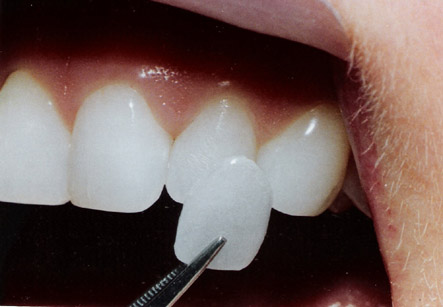Porcelain Veneers
Introduction
These are very thin shells of tooth-colored materials utilized in dentistry to cover the front surface of teeth to improve the cosmetic appearance. These shells can be different in the color, shape, size, or length of teeth. There are several types of veneers. But when a natural appearance of teeth is required, the great way to do it is by getting a porcelain veneer done.
Properties:
The color of a porcelain veneer can be selected depending upon shade of the teeth.
Porcelain veneers resist discoloration and stains. Also, the light reflecting properties of natural healthy teeth is better simulated by porcelain. However, more removal of the tooth surface is required before the placement of porcelain veneers as compared to their resin counterparts.
Iran offers a superior Dental treatments that is world best quality. For patients from the USA, and Europe for example, the savings can be 60% or more

Indications:
Porcelain veneers are used in case of:
1. Discolored teeth due to root canal treatment, drugs like tetracycline or phenytoin, excessive fluoride or the presence of large resin fillings.
2. Teeth which are worn down, chipped or broken.
3. Irregular, crooked or uneven teeth.
4. Irregular gaps between the teeth.
Procedure
There are three steps involved in getting a dental veneer. This means at least three visits to the dentist are required. These steps are described below.
1. Consultation: In this step, the dentist examines the teeth and decides whether this treatment is appropriate for the patient. He also explains the procedure and its pros and cons to the patient. It must be made sure that the dentist knows what should be achieved at the end of the procedure. A baseline X-ray can be taken of mouth and teeth.
2. Preparation: a local anesthetic is injected to numb the required area depending on the decision of the dentist. About 1/2 a millimeter of enamel is trimmed from the tooth surface, which equals to the thickness of the veneer to be added to the surface. Then, the dentist makes an impression of the tooth. The veneer is then constructed in a dental laboratory from this impression. This usually takes 1-2 weeks. Temporary dental veneers can be placed if the teeth are very unsightly.
3. Bonding: Firstly, the veneer is temporarily placed it on the tooth to examine proper fit and color. Then, it is repeatedly removed and trimmed till getting a perfect fit. The veneer color can be adjusted with the shade of cement used. Next, the tooth is cleaned and polished. This process roughens the tooth and helps in strong bonding process. The veneer is then fixed on the tooth with the help of special cement. After this, a special light beam is applied to the veneer which activates chemicals in the cement, causing it to harden swiftly. Then the excess cement is removed and final adjustments are done in the veneer. A follow-up visit in a couple of weeks is required to check the status of the gums and to once again examine the veneer’s placement.
Advantages of porcelain dental veneers:
Porcelain veneers offer the following advantages:
1. Porcelain veneers give natural appearance to teeth.
2. Veneers made of porcelain are stain resistant.
3. The color of a porcelain veneer can be selected depending upon shade of the teeth.
4. It is a conservative approach to change color and shape of the tooth.
Disadvantages of porcelain dental veneers:
1. The process is irreversible and also irreparable if they chip or crack.
2. The tooth can become more sensitive to hot and cold foods as the enamel is removed.
3. The color of veneer cannot be changed once applied as it depends on the cement used.
4. Teeth can still decay even with Porcelain veneers, so sometimes crowning has to be done.
5. They are not a good choice for individuals with unhealthy teeth i.e. tooth with decay or active gum disease or fracture. Individuals who clench and grind their teeth are not suited for porcelain veneers, as these activities crack or chip the veneers.
6. Porcelain veneers generally last for about 5 to 10 years. After this time, it should be replaced.